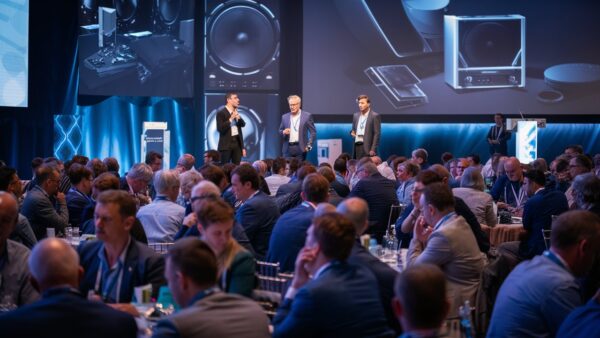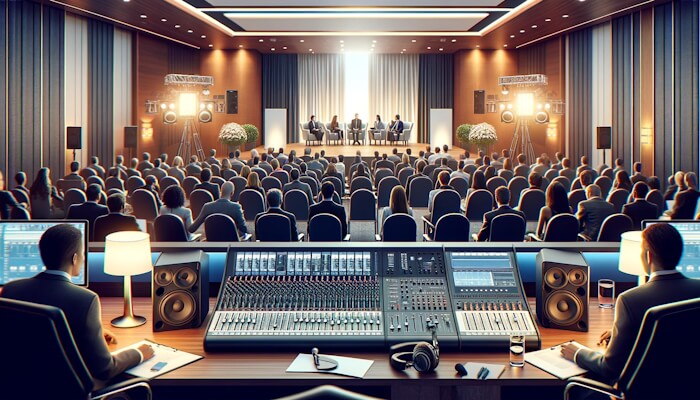Take a second to imagine you’re at a presentation, a conference, or maybe a training session.
You’re eager to soak up knowledge or new insights, but there’s a problem – the sound quality is horrible. Speakers are muffled, words get lost in distortion, and suddenly, the whole thing feels like a wasted opportunity.
It’s frustrating, right?
That’s the last thing you want to happen at your events. As an AV tech, it’s your role and responsibility to make sure that attendees have an immersive and seamless experience – especially when it comes to sound.
In this post, we’ll explore essential tips and techniques to help you achieve optimal sound quality at events, so you can ensure your next event sounds as good as it looks.
1. Consider the Acoustics
When it comes to delivering top-notch sound at events, understanding the acoustic landscape is your first step.
Every event space is unique, with its own quirks and challenges, from room size and shape to the materials used and even the ambient noise levels lurking in the background.
Each of these factors shapes the sound experience for attendees.
Room size and shape can influence how sound waves propagate, while materials like carpeting, curtains, and wall coverings can either absorb or reflect the sound.
Then you have to also consider background noise levels. Whether it’s from HVAC systems or outside traffic, it can significantly impact the quality and intelligibility of audio.
You can use certain techniques to mitigate challenges such as reverberation, echoes, and sound reflections. This includes strategic speaker placement that affects sound wave distribution and clarity (more on this below). Acoustic treatments such as sound-absorbing panels, bass traps, and diffusers can help keep reverb and echoes in check.
Even subtle layout adjustments, like rearranging seating, can minimize sound reflections and improve the overall listening experience.
2. Understand Speaker Selection and Placement
When it comes to sound, getting the right speakers in the right spots can make or break an event.
As mentioned before, every venue is unique, but in general, you can follow these guidelines:
Start by sizing up your venue (pun intended). How large is it? How many attendees will be there? What are your audio goals? Smaller venues might do fine with compact speakers, while bigger spaces need beefier systems to fill the air with clear, powerful sound.
Once you’ve got your speakers lined up, it’s all about finding their happy place in the venue.
Main speakers are your sound powerhouses and deliver the main audio for the entire venue. Position them where they can cover the whole audience area evenly, and make sure no one’s left straining to hear or getting blasted with too much noise.
In larger venues with tricky acoustics, delay speakers are a must. They help sync up the sound and keep it consistent throughout the space. Place them strategically to complement the main speakers and keep the sound flowing smoothly from front to back.
Then subwoofers are all about bringing the bass. Stick them close to the main speakers to keep that deep, rumbling sound pumping without overpowering everything else.
Finally, we have the fill speakers to support the rest by adding extra oomph to the mix. Place them where the main speakers might miss a few spots or the sound might get wonky due to weird room shapes or obstacles.

3. Master Audio Mixing and Processing
Achieving balanced audio levels is where audio mixing techniques come into play. From vocals to music, mixing makes sure everything is heard clearly without overpowering or getting lost in the mix.
Pay attention to dynamics and adjust levels accordingly to maintain a consistent sound throughout the event. Signal processing tools equalization (EQ), compression, and dynamic range control are vital for optimizing audio quality.
EQ is used to fine-tune the frequencies of your sound system and smooth out any peaks or dips in the spectrum. Compression maintains consistent sound levels and prevents sudden volume spikes or drops in the audio.
Then dynamic range control can help match a signal to its environment so soft passages are audible without being drowned out by louder sections.
These alone can work wonders in improving the sound quality at your events.
4. Capture Sounds with the Right Microphones
If you have speakers, you’re going to need the right microphone.
Think about the needs of your event and choose from a range of options, including:
- Handheld mics for dynamic presentations,
- Lapel and headset mics for hands-free operation,
- Shotgun mics for focused directional pickup, and
- Boundary mics for capturing sound in large spaces or conferences.
Once you’ve selected your microphones, you need to consider placement to minimize feedback, ambient noise pickup, and unwanted sound sources.
For handheld mics, position them close to the mouth of the speaker and remind them to try to be consistent with their distance throughout their presentation.
Lapel mics can be discreetly clipped to the presenter’s clothes; positioned relatively close to their mouth. Take care to avoid clothes rustling and other noise interference by securing it in a stable position.
Shotgun mics are ideal for capturing sound from specific sources while minimizing ambient noise. Position the microphone to point directly at the sound source and adjust the angle and distance as needed.
Finally, boundary mics are designed to be placed on flat surfaces, like podiums, to capture sound evenly across large spaces. Position the microphone centrally on the surface and tune the sensitivity to get everything just right for all presenters.
Wrapping Up
High-quality sound is a must-have for any successful event. You need the right mics, the right positions, and the technology to make sure your audio is crisp and clear.
However, managing the presentations is just as important and that’s where Preseria comes in.
With its user-friendly presentation management dashboard, Preseria empowers you to effortlessly manage your presentations, no matter how many speakers or attendees you have.
From seamlessly uploading and tracking content to ensuring smooth transitions between speakers, Preseria simplifies the presentation process, allowing you to focus on what truly matters – delivering impactful content to your audience.
Book your demo today and learn firsthand how Preseria can transform the way you manage your next event!
